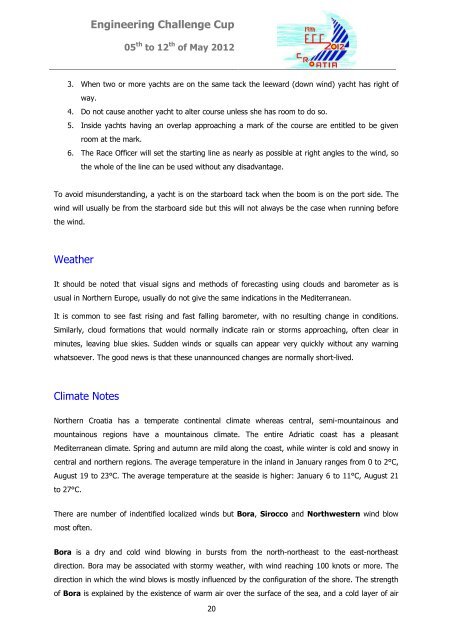ecc 2012 logbook - ECC 2013
ecc 2012 logbook - ECC 2013
ecc 2012 logbook - ECC 2013
- TAGS
- logbook
- ecc-sailing.com
You also want an ePaper? Increase the reach of your titles
YUMPU automatically turns print PDFs into web optimized ePapers that Google loves.
Engineering Challenge Cup<br />
05 th to 12 th of May <strong>2012</strong><br />
3. When two or more yachts are on the same tack the leeward (down wind) yacht has right of<br />
way.<br />
4. Do not cause another yacht to alter course unless she has room to do so.<br />
5. Inside yachts having an overlap approaching a mark of the course are entitled to be given<br />
room at the mark.<br />
6. The Race Officer will set the starting line as nearly as possible at right angles to the wind, so<br />
the whole of the line can be used without any disadvantage.<br />
To avoid misunderstanding, a yacht is on the starboard tack when the boom is on the port side. The<br />
wind will usually be from the starboard side but this will not always be the case when running before<br />
the wind.<br />
Weather<br />
It should be noted that visual signs and methods of forecasting using clouds and barometer as is<br />
usual in Northern Europe, usually do not give the same indications in the Mediterranean.<br />
It is common to see fast rising and fast falling barometer, with no resulting change in conditions.<br />
Similarly, cloud formations that would normally indicate rain or storms approaching, often clear in<br />
minutes, leaving blue skies. Sudden winds or squalls can appear very quickly without any warning<br />
whatsoever. The good news is that these unannounced changes are normally short-lived.<br />
Climate Notes<br />
Northern Croatia has a temperate continental climate whereas central, semi-mountainous and<br />
mountainous regions have a mountainous climate. The entire Adriatic coast has a pleasant<br />
Mediterranean climate. Spring and autumn are mild along the coast, while winter is cold and snowy in<br />
central and northern regions. The average temperature in the inland in January ranges from 0 to 2°C,<br />
August 19 to 23°C. The average temperature at the seaside is higher: January 6 to 11°C, August 21<br />
to 27°C.<br />
There are number of indentified localized winds but Bora, Sirocco and Northwestern wind blow<br />
most often.<br />
Bora is a dry and cold wind blowing in bursts from the north-northeast to the east-northeast<br />
direction. Bora may be associated with stormy weather, with wind reaching 100 knots or more. The<br />
direction in which the wind blows is mostly influenced by the configuration of the shore. The strength<br />
of Bora is explained by the existence of warm air over the surface of the sea, and a cold layer of air<br />
20


